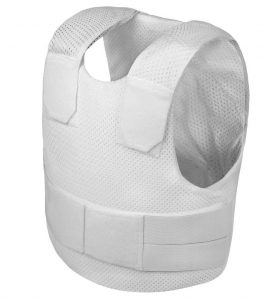Apr
2016
 Tracking down fugitives is a difficult and dangerous job, but one that Bail Bondsmen and Bounty Hunters are committed to performing to the best of their ability. However, it is unreasonable to expect you to do so with proper protection. Being able to perform confidently and securely is vital in such an important role, and a Kevlar vest – commonly known as a bullet proof vest- is necessary to making this happen.
Tracking down fugitives is a difficult and dangerous job, but one that Bail Bondsmen and Bounty Hunters are committed to performing to the best of their ability. However, it is unreasonable to expect you to do so with proper protection. Being able to perform confidently and securely is vital in such an important role, and a Kevlar vest – commonly known as a bullet proof vest- is necessary to making this happen.
Working as a Bounty Hunter or Bail Bondsman involves not only tracking a wanted and potentially dangerous individual, but associating and interacting with people who will at best be uncooperative, and at worst will be hostile. There are a number of situations that you will have to deal with, not least the tracking of a fugitive, and all will require protective clothing. However, just as the situations vary, so too do the protective options, and understanding body armour allows you to choose the correct armour for the situation.
Bullet proof vests are not one size fits all; not only are they available in a wide range of sizes, but also at different levels of protection, and in different styles of wear. The range of bullet proof vests available reflects the threats that Bounty Hunters face, and different vests are suitable for different threats. All ballistic protection should be tested and standardized according to the guidelines set by the National Institute of Justice, the world leader in ballistic testing. The grades outlined by the NIJ (NIJ Levels) clearly states what ammunition bullet proof vests can protect against.
One of the most serious threats to any Bounty Hunter is a handgun, which are not only easily accessible and very deadly, but are the most common weapons used in crime in the USA. Protecting against handguns is of the utmost importance, and a bullet proof vest at Level IIIa is capable of preventing penetration from the vast majority of handgun ammunition, including 9mm, .40 S&W, and even .44 Magnum. However, there may be instances where handguns are not the main threat. While handgun protection should be considered the minimum protection, it may be necessary to augment your armour with additional plates to stop certain threats.
It is very unlikely, but the threat of rifles, automatics and even armour-piercing ammunition is one that all Bounty Hunters should consider. The individuals you are charged with apprehending may flee to particularly dangerous areas. In these environments protection is of the utmost importance, and if there is even a small threat of attack involving rifles, automatics or other high-caliber weaponry, you will need appropriate protection. Level III and Level IV body armour is the highest protection available, and can only be achieved with hard plates of ceramics and/or polyethylene.
Hard armour plates are naturally heavier and less flexible than lower levels of ballistic protection and for those who don’t need them will only be a distraction and a hindrance. However, for those who need this protection, the extra weight and bulk is negligible. On the other hand, while handguns may not be the main threat, it may not be firearms at all, and there are a variety of weapons currently available that can be just as deadly.
There will be situations where firearms are simply not accessible. Whether it is in a particularly crowded area where they are simply not feasible, or in a place where they strictly prohibited, this does not mean that you are not at risk of attack, and at risk of an attack involving a weapon. Edged and spiked weapons like knives, needles or screwdrivers are not only very easy to obtain (or make) but can be just as deadly as a firearm, and it is important that you are protected against them.
It is not commonly known that a bullet proof vest, while capable of protecting against a wide variety of firearms and blunt trauma- including car accidents and falling debris- cannot protect against edged or spiked weapons. This is because the Kevlar used, while capable of absorbing large amounts of energy, will be cut by edged weapons like knives or axes. Similarly, spiked weapons like screwdrivers or needles can pass through the gaps between the protective fibers, rendering the vest useless. To protect against these weapons you will need a stab or spike proof vest, which uses layers of chainmail or plastic laminate in addition to Kevlar.
Understanding the different options available in protective clothing allows you to approach any situation with the correct protection, ensuring that whatever the scenario they can perform their role confidently and securely and bring to justice those who have chosen to flee. Whether a soft bullet proof vest, a hard bullet proof vest with rigid panels, or a stab or spike proof vest, protective clothing is more accessible than ever and should be considered necessary protection for any working in potentially dangerous environments.



